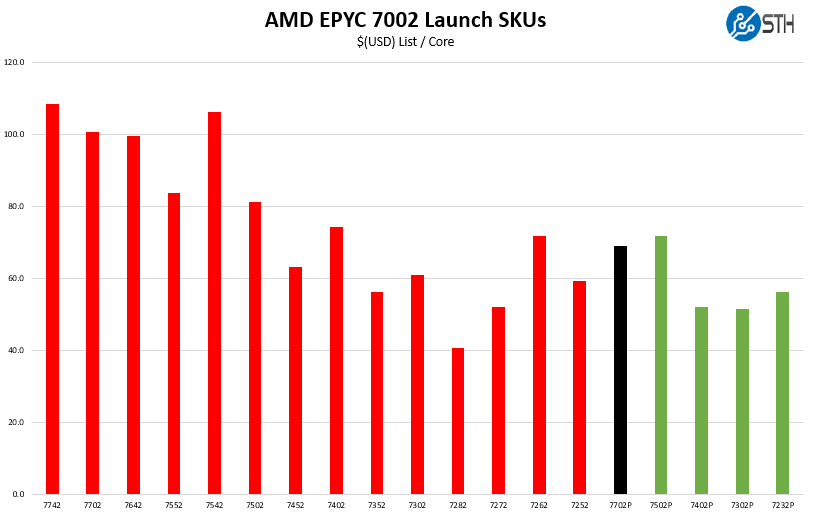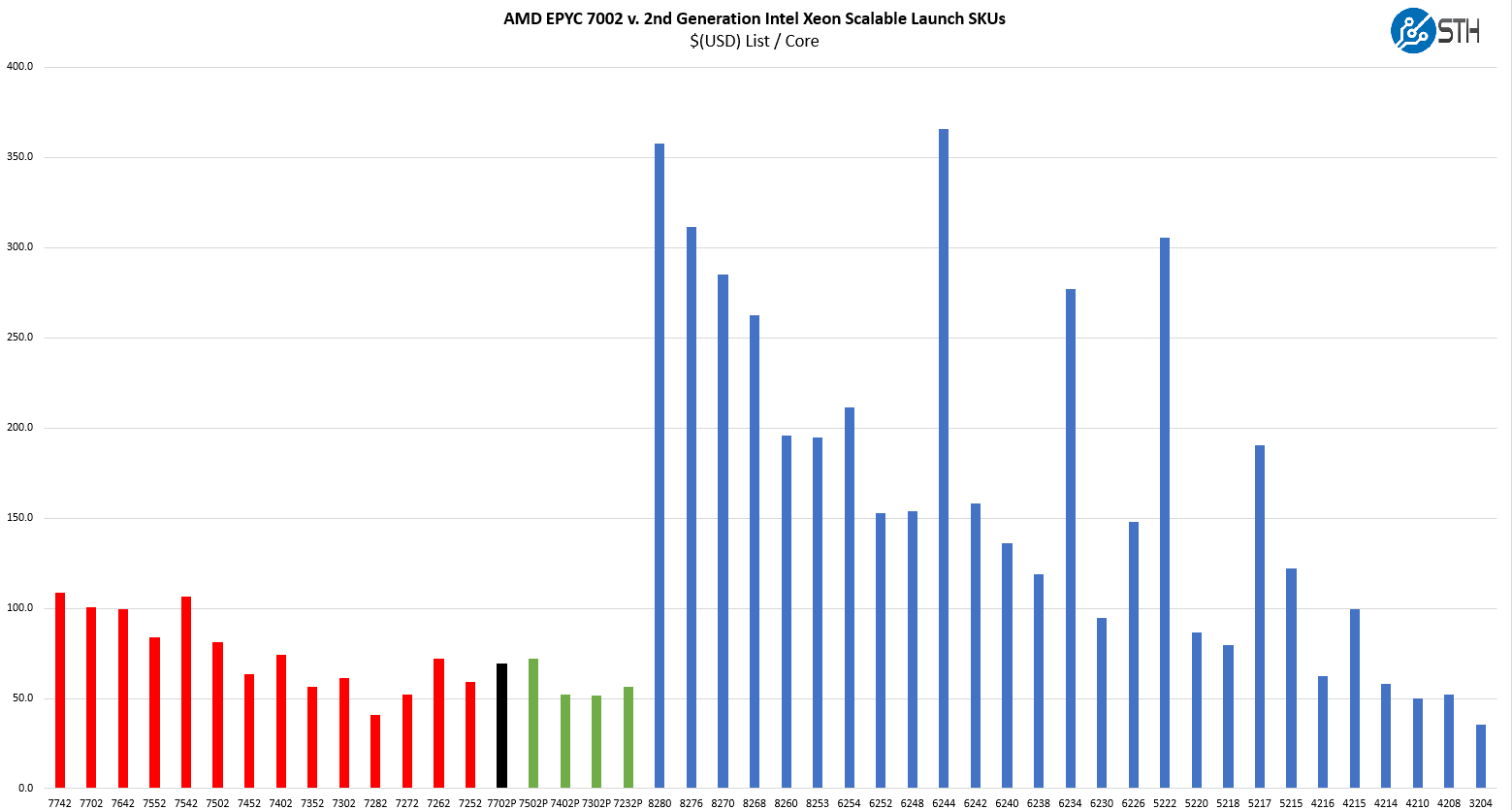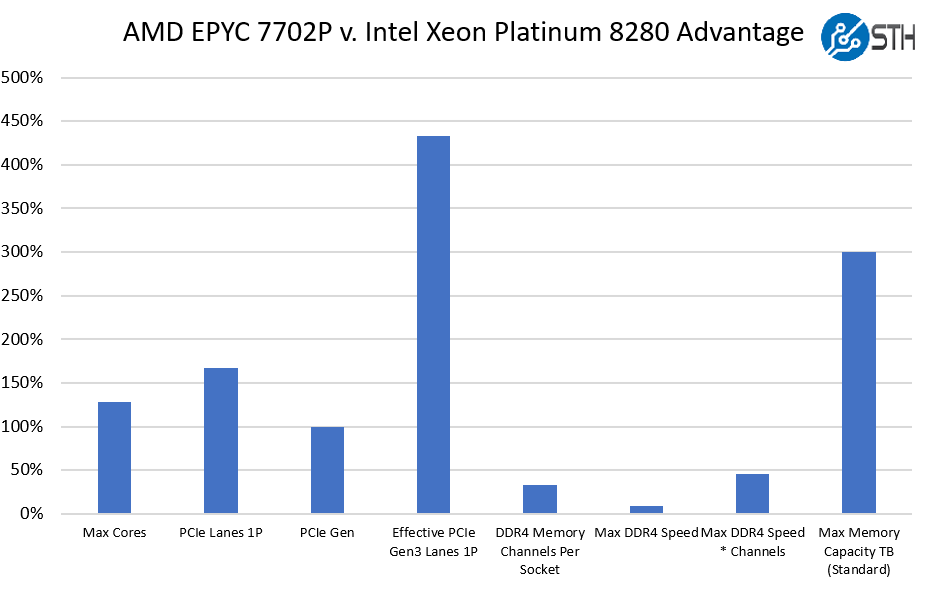AMD EPYC 7702P Market Positioning
Thes chips are not released in a vacuum instead, they have competition on both the Intel and AMD sides. When you purchase a server and select a CPU, it is important to see the value of a platform versus its competitors.
AMD EPYC 7702P v. AMD Alternatives
The AMD EPYC 7702P has serious competition from its stablemates in the AMD EPYC 7002 Series. It is one of the higher cost per core parts for the “P” family of single-socket only SKUs, and about the middle of the pack for the entire line.

For those who need more cores than the AMD EPYC 7502P offers, this is really the primary upgrade path. During the launch event, I asked AMD why there is not a 48-core EPYC “P” series part, and I was told it did not make sense given the existing pricing scale. At around $4000 there is the AMD EPYC 7552 48-core part which can be used in single-socket servers, but at that point one is better off spending the extra $400 and getting 16 cores at $25 per core. That is some of the least expensive per core incremental pricing we have seen. If AMD had a $3300 48-core “P” SKU, it would be a much tougher recommendation.
We have tested the AMD EPYC 7742 in single socket configurations as you saw on our benchmarks. Frankly, unless there is a compelling and unique reason, it is hard to justify the significant price increase. One example of where we may get the higher-end 64-core part is at the 1TB+ memory level and with multiple PCIe devices. In the context of a $100,000+ system, we think the EPYC 7742 has merit as a single socket upgrade.
AMD EPYC 7702P v. Intel Xeon Alternatives
The AMD EPYC 7702P competes against the 2nd Gen Intel Xeon Scalable line in the mainstream server market. When we plot the Intel Xeon SKUs on the same chart this is what we are seeing:

AMD is essentially pricing its premium single-socket part at a price that is about what one would pay for the Intel Xeon Silver line like the Intel Xeon Silver 4214. At the same time, it is positioned as a premium part.
Since this is AMD’s top-end single-socket CPU, let us compare its capabilities to an Intel Xeon Platinum 8280:

Features wise, it is not close. If you see how many bars are at or above the 100% line, you can see why the AMD EPYC 7702P competes with two Intel Xeon CPU configurations.
Even in single-socket mode, we see appreciably more maximum power consumption with a single Intel Xeon Platinum 8280 versus an EPYC 7702P, more than the 5W TDP delta would seem to indicate.
At the lower end of the market, Intel has some competitive offerings. At this higher-tier, there Intel is not competitive, especially once pricing is accounted for.
Intel does have three primary features that AMD does not have a direct answer to. If you need AVX-512, DL Boost (VNNI), or Intel Optane DC Persistent Memory, and they are must-have features, Intel is the way to go. We are seeing Intel push the Optane DCPMM feature as one of its main competitive selling points now.
Final Words
Most in the industry would agree, even if begrudgingly, that this 64 core AMD EPYC 7702P part is something unique and excellent in the market. It provides the ability to consolidate all of the lower-end dual Xeon Silver 4100 and Xeon E5-2600 V4 platforms by a 3:1 or a 4:1 server ratio or a 6:1 to 8:1 socket ratio. From a TCO point of view, once one includes networking, this can make a case to replace systems that are even just a year or two old. That is not something we have had in the industry for a long time.
AMD is delivering a part designed to compete with what Intel will announce in 2020, and win. Still, AMD is in-market today while we are still several quarters from Intel’s competitive offering. The two reasons we would not recommend the EPYC 7702P are if one does not need 64 cores in a single system or if one needs higher clock speeds. Otherwise, this is a chip everyone in the industry should have in their server RFPs and TCO models for the next year. The AMD EPYC 7702P is an absolutely disruptive force to the server market and is something we encourage our readers to at least evaluate for their needs.




While 7702P is excellent compared to all existing Xeon CPUs it’s not clear if/when it’s better than dual 7452 (which are cheaper, faster, has 2x RAM bandwidth and 2x RAM size limit) except under very significant power constraints (given existence of DP 2U4N servers from several vendors space doesn’t seem to be much of an issue) or if used with paid software licensed per socket.
Any other common scenario when 7702P is preferable to dual 7452s?
Igor that is something I do want to test (we do not have EPYC 7452’s yet.)
Single socket you also have lower power consumption per core, and more PCIe lanes per core. You also do not have a socket-to-socket traversal. So there are advantages as well. 2U4N EPYC runs out of space for 16 DIMMs per CPU so you are limited to 16 DIMMs per node.
Can you run open source HCI like Proxmox on it?
@Igor,
You are correct that 2x 7452 give you 2x RAM capacity+bandwidth, and CPU cycles (7452 has higher base clock — 2.9 vs. 2.2Ghz). And while 2×7452 has a smaller cost premium over the 7702 (2x$3,400 vs. $6,450). These are not the only things that need to be considered.
1 – Power and Cooling costs. TDP of 7702=225w, TDP of 2×7452=450w.
TDP == $$$, this can add up over time
2 – System cost. Proportionately, a single CPU system is less expensive than dual CPU system.
3 – Single CPU is more efficient than dual CPUs for some operations, no inter-CPU traffic.
Dawkins jr – you can. We have this running in the lab and it worked out-of-the-box.
BinkyTO – the 7702P is $4425 and the 7452’s are $2025 each. The 7542 is $3400 while the 7702 (non-P) is $6450. All list prices.
Linus Tech Tips: “BRO 64 CORES THIS IS COOL”
STH: “Here is the TCO benefit, what you can replace and why. Here are the market dynamics at play.”
Thanks for doing something useful.
The Playstation 3 actually has 512MB of RAM, split across two busses. The CELL BE can only directly access 256MB of it but the graphics and audio and some DMA can access all of it.
Hi @Patrick,
Why “… single socket you also have … more PCIe lanes per core”? It may be true for some pairs of 1-CPU vs 2-CPU motherboards (however in most cases it’s not so) but architecturally it’s the same 128 PCIe 4.0 lanes (or even more – supposedly configurable of up to 160 – lanes for 2-CPU configuration).
Looking forward to test results of dual 7452s.
This is another great review… But I still wonder why no one talks about the elephant in the room (not the Del C6525 or the Bullsequanna) but the fact that EPYC can now be 8P at one NUMA node per socket…
It is interesting that with core counts most situation can’t use 8P but HPC will love it… And Rome is seemingly made for 2P sleds… 1024 threads in a 2U4N…?
Great stuff, more nicely detailed information.
[Although I think the paragraph following the chess graph isn’t reading as you intended.]
And it seems pretty likely that dual 7402 (despite only having 48 cores) has similar or better performance than 7702P (if CPU2017_rate results are any indication)
64 cores is nice, but I do not have unlimited resources as a private person. So 16 or 24 cores EPYC WS seems the best value.